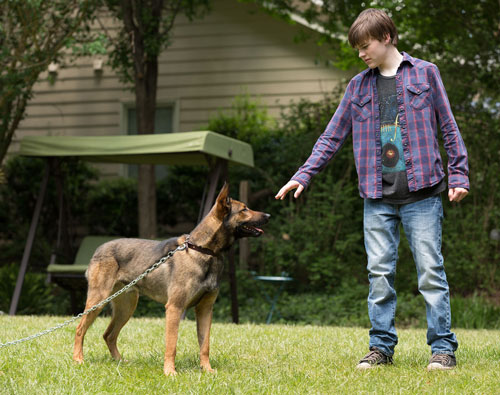This Friday marks the release of the Warner Brothers/MGM film, Max, which follows a Belgian Malinois who works as a military dog. When his handler is killed in action in Afghanistan, the dog, stricken with post-traumatic stress disorder from the loss of his handler, returns to the United States to live with the soldier’s heartbroken family. Together, Max and his handler’s young brother try to pick up the pieces and heal themselves through a newfound friendship.
On the screen, you’ll see a seemingly damaged dog who must overcome aggression and severe stress. But playing that role is a group of five gentle Belgian Malinois. We sat down with the film’s dog trainer, Mark Forbes, to find out what went into preparing these dogs for their role, and what we can learn from this film.
Tell us about the background of the dogs who played Max. Have they been in films before?
There were five dogs were played the role, and none had any film experience. A few of them were trained in other activities, which is important because Belgian Malinois need a job to do. Carlos was the lead dog—we called him “the face.” He came from a breeder in the south, and had been competing in agility. Pax came to us from Salt Lake City. He was actually a fully trained narcotics sniffing dog who worked with a private contractor. Dude was the pet dog of one of the other trainers, and Jagger and Pilot came from breeders in New Mexico and Ohio, respectively.
How did you prepare them for the movie?
One important aspect of training a dog who has never been on a movie set is to help them get over the fear of a new situation. We take them to stores or a theme park so when they are on set, it’s just another new, busy place to them. I always say that a big part of our job is making it fun for the dogs. I can’t give them a bigger paycheck, so instead I make sure they enjoy doing whatever is required of them in the script.
There are some pretty intense dog-fighting scenes in the film. How did you pull that off safely?
What you’re seeing there is nothing more than two puppies playing. Pilot was used for most of the fighting scenes. We picked her purposely for those scenes because she was a puppy—only 9 to 10 months old—so she had that play mentality. The fighting scenes were her just playing with a young Rottweiler. They would play all the time if we let them! Then we just added in some growls and snarls. You can do amazing things with sound effects and slow motion.
How did you prepare the actors for working with the dogs?
To get a relationship that shows up on camera as a bond, you need a bit of time. This was important, especially with Josh, who plays the little boy in the film. Sometimes the dogs will be following the trainer’s direction from off camera, but there are a few scenes in the movie where Josh is in the scene working the dog himself. For instance, there’s one scene where Josh’s character is training Max—that was all real.

Josh Wiggins working with one of the dogs who played Max
What training tips do you have for the average pet owner?
It’s not rocket science. There’s no substitute for time, so spend a lot of time with your dogs. And be consistent. Dogs want to know what the rules are in the pack, and they get confused when the rules change. They really do want to do what you want them to do. If you’re clear about your expectations with very little gray area, that will cut training time down quite a bit. We use treats on set as motivation because there are distractions, but you’ll find a pat on the head means just as much as the treat. Praise them even when you’re teaching them not to do something. Make it fun, and make it positive.
What was it like working with Belgian Malinois?
This was the first time I worked with Belgian Malinois, and although it’s a great breed, it’s not for everybody. They have a motor that never stops. There’s a reason they use them for this kind of work. They’ll go all day, and they need a physical job that challenges them. This is not your Golden Retriever you can leave at home all day and expect the home to be in one piece when you get back if they’re not doing a job on a regular basis. They’re an amazing dog and breed. But they’re intense and are not going to make a great pet for the average person. (Read more about that here.)
What’s the takeaway from this movie?
There is redemption for everybody and everything. The “bad dog” today doesn’t have to be a bad dog tomorrow. The dog in the film was affected by circumstances, and with the help of humans and the handler who was killed overseas, he found his purpose again. It shows that with rehabilitation and the right environment, anyone can come back.
The Warner Brothers/MGM movie stars Josh Wiggins, Lauren Graham, Thomas Haden Church, Robbie Amell, Luke Kleintank, and Jay Hernandez.
See the trailer below:
Adapted from an article from AKC Family Dog
Images courtesy Warner Brothers
“

